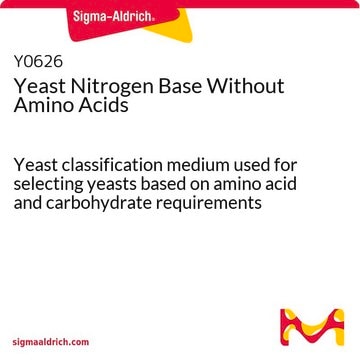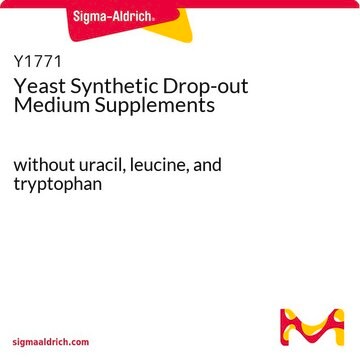OGS538
PSF-TPI1-URA3 - STRONG PROMOTER YEAST PLASMID
plasmid vector for molecular cloning
Sinonimo/i:
cloning vector, expression vector, molecular cloning vector, plasmid, plasmid vector, snapfast vector, vector
About This Item
Prodotti consigliati
Stato
buffered aqueous solution
PM
size 7023 bp
Selezione batterica
kanamycin
Origine di replicazione
2Micron
pUC (500 copies)
Clivaggio proteico
no cleavage
Promotore
Promoter name: TEF1
Promoter activity: constitutive
Promoter type: yeast
Gene reporter
none
Condizioni di spedizione
ambient
Temperatura di conservazione
−20°C
Selezione lieviti
uracil
Descrizione generale
Promoter Expression Level: This plasmid contains the strong yeast constitutive triosephosphate isomerase (TPI1) gene promoter. It demonstrates similar levels of expression to the translation elongation factor 1 promoter.
Applicazioni
Multiple cloning site notes: There are a few important sites within the MCS. These include the NcoI site the XbaI site and the BsgI and BseRI sites. The NcoI site contains a start codon that is immediately downstream of both a Kozak and Shine-Dalgarno ribosomal binding site. These allow for optimal positioning of genes when the start codon is placed in this location. If this is not required and you wish to use a downstream site for gene cloning you can remove the NcoI site by cleaving the plasmid with KpnI.
The XbaI site contains a stop codon. This stop codon is positioned in a specific position in relation to the BsgI and BseRI sites that are immediately downstream. When either BseRI or BsgI cleave the plasmid they produce a TA overhang from the stop codon in the XbaI site that is compatible with all of our peptide tag plasmids cut with the same sites. BseRI and BsgI sites are non-palindromic and cleave a defined number of bases away from their binding site.
Whenever we clone a gene into our multiple cloning site we always position the start and stop codon in the same positions in the MCS. If the start and ends of the genes are not compatible with NcoI and XbaI we extend the sequence to the nearest external sites but keep the start and stop codons locations consistent.
Sequenza
Prodotti correlati
Codice della classe di stoccaggio
12 - Non Combustible Liquids
Punto d’infiammabilità (°F)
Not applicable
Punto d’infiammabilità (°C)
Not applicable
Scegli una delle versioni più recenti:
Certificati d'analisi (COA)
It looks like we've run into a problem, but you can still download Certificates of Analysis from our Documenti section.
Se ti serve aiuto, non esitare a contattarci Servizio Clienti
Possiedi già questo prodotto?
I documenti relativi ai prodotti acquistati recentemente sono disponibili nell’Archivio dei documenti.
Filtri attivi
Il team dei nostri ricercatori vanta grande esperienza in tutte le aree della ricerca quali Life Science, scienza dei materiali, sintesi chimica, cromatografia, discipline analitiche, ecc..
Contatta l'Assistenza Tecnica.








